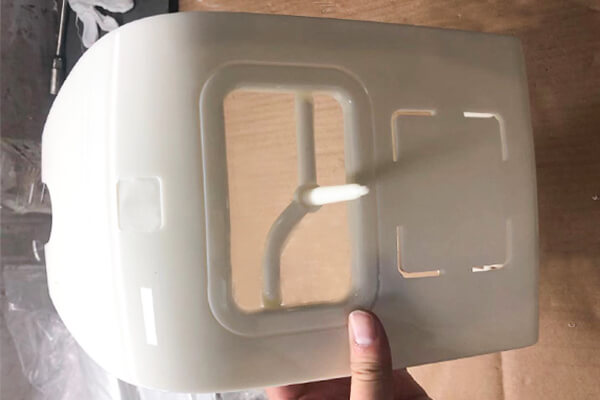ABS Molding: Tips for Creating High-Quality ABS Parts
Sungplastic excels in ABS molding and offers a seamless manufacturing process for customers of all sizes, spanning from prototype development to full-scale production.

What is ABS?
ABS, or Acrylonitrile Butadiene Styrene, is a lightweight and rigid plastic known for its exceptional durability and impact resistance. ABS derives its name from the three key monomers it comprises: acrylonitrile, butadiene, and styrene. Each of these monomers contributes distinct properties to the final plastic. Acrylonitrile provides heat and chemical resistance, butadiene enhances impact resistance, and styrene imparts additional strength and a glossy finish to ABS. This versatile material finds applications in a wide range of products, including household appliances, toys, medical equipment, musical instruments, computer components, and more.
One iconic example of ABS molding is the familiar LEGO® brick. LEGO® bricks exemplify the characteristics that make ABS an ideal choice for diverse projects: toughness, scratch resistance, impact resistance, and a smooth, glossy surface finish.

Is ABS Plastic Strong?
ABS, a widely-used thermoplastic polymer in injection molding, indeed exhibits strength as one of its prominent features. ABS boasts durability, affordability, and ease of machining. Moreover, ABS can be effectively paired with a metal coating, as many metals adhere firmly to its surface. This plastic demonstrates commendable resistance to extreme temperatures and humidity, making it a solid choice for projects requiring strength, stiffness, and impact resistance. ABS also proves highly amenable to secondary processing, allowing for easy painting and gluing. Additionally, ABS stands out for its recyclability.
The strength and properties of ABS molding products are contingent on the temperature conditions during the manufacturing process. High-temperature ABS molding yields heat resistance and a sleek, glossy finish, while lower-temperature molding enhances strength and impact resistance. The specific parameters used during production significantly influence the final properties and strength of ABS molding items. The experts at Sungplastic are well-equipped to assist customers in selecting the optimal parameters for their upcoming ABS molding projects.
Why is ABS an Ideal Choice for Injection Molding?
ABS molding presents a host of advantages when compared to other plastic materials. ABS plastic is exceptionally moldable and boasts excellent machinability. It exhibits remarkable attributes such as high impact and tensile strength, dimensional stability, stiffness, and exceptional load-bearing capacity. ABS maintains its performance in extreme temperature conditions while also featuring a low melting point, rendering it highly suitable for injection molding processes. Furthermore, ABS can be blended with other polymers to achieve specific desired characteristics, and it can be easily colored to meet custom requirements. Its ease of painting and gluing makes it a practical choice for secondary processing tasks.
ABS plastic is environmentally responsible as it is recyclable. By combining virgin ABS plastic with recycled ABS, customers can effectively reduce overall costs. The recycling process involves shredding ABS plastic and subsequently purifying it to eliminate undesirable metals or plastics. The resulting material is then analyzed and combined with virgin ABS to create a new product ready for injection molding.
However, it’s important to note that ABS plastic should not be exposed to direct sunlight or open flames. Fire-retardant and heat-resistant ABS grades are available to address these specific concerns. Additionally, some ABS components may emit toxic fumes when heated, so proper precautions must be taken in such cases.
How is ABS Molded?
Material Preparation
The process begins with ABS plastic material in the form of small pellets. These pellets may be sourced as virgin ABS or a blend of recycled and virgin ABS, depending on the specific requirements.
Melting
The ABS pellets are introduced into a hopper, where they are conveyed into a heating chamber. Inside the heating chamber, the pellets are subjected to high temperatures, causing them to melt and become a viscous, moldable liquid.
Injection
Once the ABS material has reached the desired molten state, it is injected into the mold. The mold consists of two halves, known as the “cavity” and “core,” which together define the shape of the desired part. The molten ABS is forced into the mold cavity through a runner and gate system under high pressure.
Cooling and Solidification
As the molten ABS enters the mold cavity, it rapidly cools and solidifies. Cooling can be accelerated through the use of cooling channels within the mold. The cooling process is critical, as it determines the final part’s shape, dimensions, and properties.
Ejection
After the ABS has solidified and taken on the shape of the mold, the mold opens, and the part is ejected. Ejection can be accomplished through various methods, including ejector pins, air blasts, or other mechanical means.
Mold Closure and Repeat
Once the part is removed, the mold closes, and the process begins anew. This cycle is repeated continuously to produce multiple identical parts.
Quality Control
Throughout the process, quality control measures are in place to ensure that each molded part meets the specified tolerances, dimensions, and quality standards. This may include visual inspection, dimensional checks, and other testing as needed.
The precise details of ABS molding can vary depending on factors such as the complexity of the part, the type of mold used, and the specific requirements of the project. Proper mold design, temperature control, and injection pressure are crucial to achieving high-quality ABS molded parts.
Sungplastic: ABS Molding Manufacturer Serve for You
At Sungplastic, we have the knowledge to handle your ABS molding needs. We combine rapid and dependable service with affordable prices, quick quotes, and an advanced project production system. Sungplastic has the capacity to handle projects of any size, whether they are small-scale, include prototyping, or involve larger runs that include hundreds or even millions of pieces.
Please direct discuss your ABS molding projects with us, if you are looking for an ABS molding company.
Get a free quote and design analysis today.
We’ll reply to you within 6 working hours.
We respect your privacy.
+86 139 2927 4777 (WhatsApp, Wechat)
